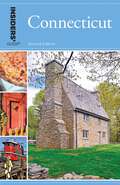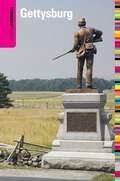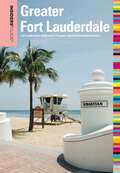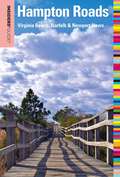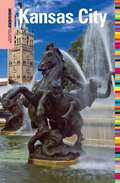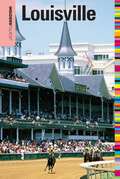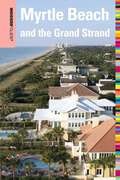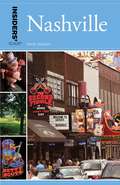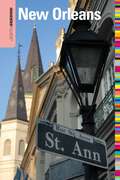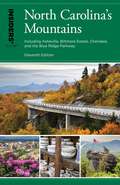- Table View
- List View
Insiders' Guide® to Connecticut (Insiders' Guide Series)
by Eric D. LehmanInsiders' Guide to Connecticut is the essential source for in-depth travel information for visitors and locals to the Nutmeg State. Written by a local (and true insider), Insiders' Guide to Connecticut offers a personal and practical perspective of the state that makes it a must-have guide for travelers as well as residents looking to rediscover their home state.
Insiders' Guide® to Dallas & Fort Worth (Insiders' Guide Series)
by June NaylorYour Travel Destination. Your Home. Your Home-To-Be.Dallas & Fort Worth&“Fort Worth is where the West begins,&” it&’s said, &“and Dallas is where the East peters out.&” • A personal, practical perspective for travelers and residents alike• Comprehensive listings of attractions, restaurants, and accommodations• How to live & thrive in the area—from recreation to relocation• Countless details on shopping, arts & entertainment, and children&’s activities
Insiders' Guide® to Denver (Insiders' Guide Series)
by Eric LindbergInsiders' Guide to Denver is the essential source for in-depth travel information for visitors and locals alike to this storied Colorado city. Written by a local, and true insider, Insiders' Guide to Denver offers a personal and practical perspective of Denver and its surrounding environs that makes it a must-have guide for travelers as well as residents looking to rediscover their hometown.
Insiders' Guide® to Des Moines (Insiders' Guide Series)
by Michael ReamA first edition, Insiders' Guide to Des Moines is the essential source for in-depth travel and relocation information to Iowa's capital. Written by a local (and true insider), this guide offers a personal and practical perspective of Des Moines and its surrounding environs.
Insiders' Guide® to El Paso (Insiders' Guide Series)
by Megan EavesA first edition, Insiders' Guide to El Paso is the essential source for in-depth travel and relocation information to this legendary Texas panhandle area with wild west charm. Written by a local (and true insider), this guide offers a personal and practical perspective of El Paso and its surrounding environs.
Insiders' Guide® to Florida Keys & Key West
by Juliet Dyal GrayWritten by a local and true insider, Insiders' Guide to Florida Keys & Key West is the essential source for in-depth travel and relocation information. Each guide is packed with useful tips on places to stay, restaurants, events, attractions, fun things to do with the kids, nightlife, recreation, shopping, local history, and much more--as well as information on real estate, education, health care, and more.The new edition features:Comprehensive listings of restaurants, attractions, activities, nightlife, and accommodationsCountless details on shopping, arts & entertainment, and children&’s activitiesAdvice on how to live and thrive in the area—from recreation to relocation
Insiders' Guide® to Gettysburg (Insiders' Guide Series)
by Kate HertzogInsiders' Guide to Gettysburg is the essential source for in-depth travel and relocation information to this historic city.
Insiders' Guide® to Greater Fort Lauderdale: Fort Lauderdale, Hollywood, Pompano, Dania & Deerfield Beaches (Insiders' Guide Series)
by Steve Winston Caroline SiegA first edition, Insiders' Guide to Greater Fort Lauderdale is the essential source for in-depth travel and relocation information to this beautiful Florida region. Written by a local (and true insider), this guide offers a personal and practical perspective of Fort Lauderdale and its surrounding environs.
Insiders' Guide® to Hampton Roads: Virginia Beach, Norfolk & Newport News (Insiders' Guide Series)
by Anthony GermanottaA first edition, Insiders' Guide to Hampton Roads is the essential source for in-depth travel and relocation information to this storied Virginia metropolitan area. Written by a local (and true insider), this guide offers a personal and practical perspective of Hampton Roadsand its surrounding environs.
Insiders' Guide® to Houston (Insiders' Guide Series)
by Laura Nathan-GarnerFor more than twenty years, the Insiders' Guide series has remained the essential source for in-depth travel and relocation information. Written by locals and true insiders, each guide is packed with useful tips on places to stay, restaurants, events, attractions, fun thnigs to do with the kids, nightlife, recreation, shopping, local history, and much more--as well as a comprehensive appendix called "Living Here" that offers information on real estate, education, health care, and more.
Insiders' Guide® to Indianapolis (Insiders' Guide Series)
by Jackie Sheckler FinchA first edition, Insiders' Guide to Indianapolis is the essential source for in-depth travel and relocation information to Indiana's capital city. Written by a local (and true insider), this guide offers a personal and practical perspective of Indianapolis and its surrounding environs.
Insiders' Guide® to Jacksonville (Insiders' Guide Series)
by Sarah ReissYour Travel Destination. Your Home. Your Home-To-Be.JacksonvilleA fast-growing Southern city. Historical landmarks aplenty. Family-style fare and fine cuisine. A robust business scene. World-class resorts. Sandy beaches galore. • A personal, practical perspective for travelers and residents alike• Comprehensive listings of attractions, restaurants, and accommodations• How to live & thrive in the area—from recreation to relocation• Countless details on shopping, arts & entertainment, and children&’s activities
Insiders' Guide® to Kansas City (Insiders' Guide Series)
by Katie Van LucheneYour Travel Destination. Your Home. Your Home-To-Be.Kansas CityWorld-class museums. Historic jazz clubs. Romantic cafes. Riverboat casinos. High-end cuisine. Down-home barbecues. • A personal, practical perspective for travelers and residents alike• Comprehensive listings of attractions, restaurants, and accommodations• How to live & thrive in the area—from recreation to relocation• Countless details on shopping, arts & entertainment, and children&’s activities
Insiders' Guide® to Long Island (Insiders' Guide Series)
by Jason RichYour Travel Destination. Your Home. Your Home-To-Be.Long IslandExplore a 118-mile-long reason to love New York. Experience the best of Nassau and Suffolk Counties. Savor the beaches, the fresh seafood, the local wines.• A personal, practical perspective for travelers and residents alike• Comprehensive listings of attractions, restaurants, and accommodations• How to live & thrive in the area—from recreation to relocation• Countless details on shopping, arts & entertainment, and children&’s activities
Insiders' Guide® to Louisville (Insiders' Guide Series)
by David DomineInsiders' Guide to Louisville is the essential source for in-depth travel and relocation information to this storied Kentucky city. Written by a local (and true insider), this guide offers a personal and practical perspective of Louisville and its surrounding environs.
Insiders' Guide® to Madison, WI (Insiders' Guide Series)
by Kevin RevolinskiA first edition, Insiders' Guide to Madison is the essential source for in-depth travel and relocation information to this thriving Wisconsin city. Written by a local (and true insider), this guide offers a personal and practical perspective of Madison and its surrounding environs.
Insiders' Guide® to Massachusetts (Insiders' Guide Series)
by Maria OliaInsiders' Guide to Massachusetts is the essential source for in-depth travel information for visitors and locals to the Bay State. Written by a local, and true insider, Insiders' Guide to Massachusetts offers a personal and practical perspective of the state that makes it a must-have guide for travelers as well as residents looking to rediscover their home state.
Insiders' Guide® to Memphis (Insiders' Guide Series)
by Rebecca FinlaysonIs Memphis on your list of possible places to relocate or visit? You&’ll find this practical guide an essential resource for comprehensive information about this fast-growing city. Local author Rebecca Finlayson offers an unbiased perspective of Memphis and the area around it. Four maps and 30 black-and-white photographs complete the coverage.
Insiders' Guide® to Miami (Insiders' Guide Series)
by Dara BramsonA first edition, Insiders' Guide to Miami is the essential source for in-depth travel and relocation information to Florida's top tropical destination. Written by a local (and true insider), this guide offers a personal and practical perspective of Miami and its surrounding environs.
Insiders' Guide® to Myrtle Beach and the Grand Strand (Insiders' Guide Series)
by Janice McDonaldInsiders' Guide to St. Myrtle Beach and the Grand Strand is the essential source for in-depth travel and relocation information to this popular South Carolina vacation destination. Written by a local (and true insider), it offers a personal and practical perspective of Myrtle Beach and environs. Fully revised and updated, the 10th edition also features a new interior layout and a new cover treatment.
Insiders' Guide® to Nashville
by Jackie Sheckler FinchNashville offers extraordinary opportunities for those either visiting or seeking to relocate to this country music mecca. Insiders&’ Guide to Nashville is packed with information on the best attractions, restaurants, accommodations, shopping and events from the perspective of one who knows the area well.
Insiders' Guide® to Nashville
by Jackie Sheckler FinchNashville offers extraordinary opportunities for those either visiting or seeking to relocate to this country music mecca. Insiders&’ Guide to Nashville is packed with information on the best attractions, restaurants, accommodations, shopping and events from the perspective of one who knows the area well.
Insiders' Guide® to New Orleans (Insiders' Guide Series)
by James Gaffney Becky RetzExperience the buzz of Bourbon Street and the French Quarter. Savor midnight mystery and simple pleasures. • A personal, practical perspective for travelers and residents alike• Comprehensive listings of attractions, restaurants, and accommodations• How to live & thrive in the area—from recreation to relocation• Countless details on shopping, arts & entertainment, and children&’s activities
Insiders' Guide® to North Carolina's Mountains: Including Asheville, Biltmore Estate, Cherokee, and the Blue Ridge Parkway (Insiders' Guide Series)
by Constance E. Richards Kenneth L. RichardsInsiders' Guide to North Carolina's Mountains is the essential source for in-depth travel and relocation information to the region that includes Asheville, Biltmore Estate, Cherokee, Blue Ridge Parkway, and other nearby environs. Written by a local (and true insider), this guide offers a personal and practical perspective of the area and its surrounding environs.
Insiders' Guide® to North Carolina's Outer Banks (Insiders' Guide Series)
by Kip TabbWritten by a local and true insider, Insiders' Guide to North Carolina's Outer Backs is the essential source for in-depth travel and relocation information. Each guide is packed with useful tips on places to stay, restaurants, events, attractions, fun things to do with the kids, nightlife, recreation, shopping, local history, and much more--as well as information on real estate, education, health care, and more.
